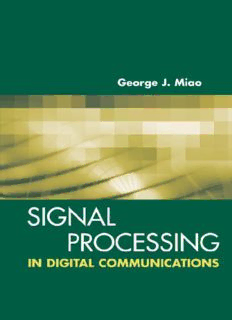Table Of ContentSignal Processing in
Digital Communications
i
ii SignalProcessinginDigitalCommunications
Signal Processing in
Digital Communications
First Edition
George J. Miao
ARTECHHOUSE
iii
Library of Congress Cataloging-in-Publication Data
A catalog record for this book is available from the U.S. Library of Congress.
British Library Cataloguing in Publication Data
A catalogue record for this book is available from the British Library.
ISBN: 1-58053-667-0
ISBN 13: 978-1-58053-667-7
Cover design by Yekaterina Ratner
© 2007 ARTECH HOUSE, INC.
685 Canton Street
Norwood, MA 02062
Allrightsreserved.PrintedandboundintheUnitedStatesofAmerica.Nopartofthisbookmay
bereproducedorutilizedinanyformorbyanymeans,electronicormechanical,includingpho-
tocopying,recording,orbyanyinformationstorageandretrievalsystem,withoutpermissionin
writingfromthepublisher.Alltermsmentionedinthisbookthatareknowntobetrademarksor
servicemarkshavebeenappropriatelycapitalized.ArtechHousecannotattesttotheaccuracyof
thisinformation. Useofaterminthisbookshouldnotberegardedasaffectingthevalidity of
any trademark or service mark.
10 9 8 7 6 5 4 3 2 1
iv SignalProcessinginDigitalCommunications
ToLisa,Kathleen,and Julia
Contents
Preface xv
1 Introduction 1
1.1 AHistory of Communications UsingElectricity 1
1.2 Digital Communication Systems 3
1.3 Digital RFSystems 6
1.3.1 Digital Transceivers 7
1.3.2 A/D Converter Challenge 9
1.3.3 Digital Downconversion and Channelization 12
1.4 LinkBudget 17
1.4.1 NoiseFigure 19
1.4.2 ReceiverSensitivity 19
1.4.3 Maximum PathLoss 20
1.5 Summary 21
References 22
2 Probability, Random Variables, and Stochastic Signal
Processing 25
2.1 Introduction 25
2.2 Probability 26
2.2.1 Intuitive Probability 27
2.2.2 Axiomatic Probability 27
2.2.3 Conditional Probability 29
2.2.4 Independence 31
2.3 Random Variables 31
2.4 Probability Distributions andDensities 32
2.4.1 Probability Distributions 32
2.4.2 Probability Densities 33
2.4.3 Joint Probability Distributions andDensities 34
vii
viii SignalProcessinginDigitalCommunications
2.4.4 StatisticalAveragesandJoint Moments 35
2.4.5 Moment Generation Function 37
2.5 Functionsof Random Variables 39
2.5.1 Sumsof Random Variables 39
2.5.2 Transformations of RandomVariables 43
2.6 DiscreteDistributions and Densities 45
2.6.1 DiscreteUniform Distribution 45
2.6.2 Binomial Distribution 46
2.6.3 PoissonDistribution 48
2.7 Continuous Distributions andDensities 51
2.7.1 GaussianDensityFunction 51
2.7.2 Error Function 54
2.7.3 Q-Function 56
2.7.4 Multivariate GaussianDistribution 58
2.7.5 Uniform Density Function 58
2.7.6 Chi-Square Distribution 60
2.7.7 F Distribution 61
2.7.8 Rayleigh Distribution 63
2.7.9 RiceDistribution 64
2.8 Upper Boundson theProbability 66
2.8.1 ChebyshevInequality 67
2.8.2 LawofLargeNumbers 68
2.8.3 Central Limit Theorem 69
2.9 StochasticSignalProcesses 70
2.9.1 Definition of Discrete-TimeRandomProcess 71
2.9.2 Stationary Processes 73
2.9.3 EstimatedFunctions 73
2.9.4 PowerSpectrum 74
2.9.5 StochasticProcessesfor LinearSystems 76
2.9.6 MeanSquareEstimation 81
2.10 Detection TheoryandOptimum Receivers 83
2.10.1 Optimality Criterion 83
2.10.2 Maximum Likelihood Detector 85
2.10.3 Probability ofError 87
2.11 Summary 87
References 89
3 SamplingTheory 91
3.1 Introduction 91
Contents ix
3.2 Discrete-TimeSampledSignals 92
3.2.1 Instantaneous Sampling 92
3.2.2 Ideal SampledSignal 94
3.3 Nyquist Sampling Theorem 94
3.3.1 Time-Domain Interpolation Formula 96
3.3.2 Frequency-Domain Interpolation Formula 98
3.3.3 Aliasing 99
3.4 Undersampling 100
3.4.1 Minimum Sampling Rate 102
3.4.2 Antialiasing BandpassFilter 103
3.5 StochasticSampling Theorem 105
3.6 Summary 106
References 108
4 ChannelCapacity 109
4.1 Introduction 109
4.2 GaussianChannelCapacity 110
4.3 Bandlimited ChannelCapacity 112
4.4 MIMOChannel Capacity 117
4.5 SIMOChannelCapacity 121
4.6 MISOChannelCapacity 121
4.7 Summary 122
References 123
5 SmartAntennaSystems 125
5.1 Introduction 125
5.2 SmartAntennas andBeamforming Structures 126
5.2.1 SwitchedBeamforming 126
5.2.2 Delay-and-Sum Beamforming 128
5.2.3 Space-TimeBeamforming 129
5.2.4 Interpolation Beamforming 130
5.3 Beamforming Algorithms 133
5.3.1 MMSEBeamformer 133
5.3.2 Maximum SNRof theBeamformer 135
5.3.3 Minimum VarianceBeamformer 137
5.4 Summary 139
References 140
x SignalProcessinginDigitalCommunications
6 ChannelCharacterizationandDistortion 141
6.1 Introduction 141
6.2 WirelessChannels 143
6.2.1 FreeSpacePropagation 143
6.2.2 FlatSurfacePropagation 146
6.2.3 Multipath Propagation 148
6.2.4 Parametersof Multipath Channels 150
6.2.5 FadingCharacteristics 156
6.2.6 Large-ScaleFading 157
6.2.7 Small-ScaleFading 159
6.3 WiredChannels 163
6.3.1 TransmissionLoop 163
6.3.2 Crosstalk 168
6.3.3 Simulation LoopModel 169
6.4 ChannelDistortion 171
6.4.1 Intersymbol Interference 172
6.4.2 EyeDiagrams 174
6.4.3 Nyquist Criterion 178
6.5 PulseShaping 180
6.5.1 Raised-CosinePulse 181
6.5.2 GaussianShapingPulse 182
6.6 MatchedFiltering 183
6.7 Summary 184
References 187
7 ChannelEstimationandBlindIdentification 189
7.1 Introduction 189
7.2 Discrete-TimeChannelModels 191
7.3 ChannelEstimators 194
7.3.1 Maximum Likelihood Estimator 194
7.3.2 LeastSquaresEstimator 198
7.3.3 GeneralizedLeastSquaresEstimator 201
7.3.4 MMSEEstimator 202
7.4 Adaptive ChannelEstimation andAlgorithms 208
7.4.1 TheLMSAlgorithms 210
7.4.2 TheLMSAlgorithm Convergence 214
7.4.3 TheLMSEMSEAnalysisandMisadjustment 217
7.4.4 TheRLSAlgorithms 219
7.4.5 TheRLSAlgorithm Convergence 223
Description:Издательство Artech House, 2007, -533 pp.Modern digital communications correspond to a major change in the design paradigm shift from fixed, hardware-intensive to multiband, multimode, and software-intensive for digital communication radios that a large portion of the signal processing f

